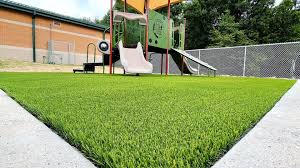Artificial grass may require little maintenance, but harsh elements can cause it to wear and tear. Caring for artificial turf involves stain and wear management. Here are ways to protect your artificial grass from the elements:
Remove Snow
During winter, the accumulated snow can melt and drain through the artificial turf. If your yard has too much snow, gently remove it using a plastic shovel. Brush the turf with a plastic rake to return the blades to upright positions. Layers of compacted ice on your artificial grass can make the turf blades brittle. Avoid using anti-freeze products to melt snow as they compromise the turf drainage system. Some synthetic grass has an Enviroloc backing system with an efficient drainage pattern. Salt clogs the backing and diminishes the drainage capability of the grass.
Tread Lightly During Icy Conditions
Extended exposure to ice makes the turf blades fragile. Allow your artificial turf to thaw before using it normally to prevent blade breakage. Until the weather becomes warmer, find new areas for children to play. Once the snow melts, the turf returns to its natural state.
Opt For UV-Stable Artificial Grass
Depending on the type of turf installed, it may be sensitive to harsh climates. The infill might not support the artificial grass blades’ upright position. Weakened blades become damaged further by foot traffic due to public use. Install artificial turf that offers UV resistance from excessive sunlight. UV treatment protects each blade from the sun, and your lawn remains green longer. Professionals equip the turf with reflective color pigments to cool its surface.
Remove Leaves and Branches
Strong winds may carry debris and deposit it on your lawn. Some types of debris, such as leaves or branches, can become matted to your artificial grass over time. Heavy twigs and sticks flatten your lawn, leaving a noticeable mark. Check for heavy items on your grass after a strong wind episode. You can scan your yard daily and pick any item you spot. Raking the lawn with a bamboo or plastic rake helps eliminate debris. Gather up flower petals, fallen leaves, and other organic material on your lawn.
Rinse With a Hose
Rinse your artificial grass occasionally to remove dust, dirt, and pollen brought by wind. Spraying turf with water prevents dirt and pollen buildup. Dust buildup may make your lawn appear dirty and faded. A power washer gets to the fiber nooks and crannies that manual cleaning cannot. Use a gentle cleanser to avoid discoloration of the turf material. Keep the pressure washer nozzle away from turf fibers to avoid damage. Rinse the turf thoroughly to remove detergent that may stain the turf. Avoid using bleach when cleaning, as it can strip away the turf’s protective coating.
Learn More About Artificial Turf
Proper cleaning and covering your yard help protect your turf from the elements. Keeping the lawn free from snow and dirt keeps it functional and beautiful. Contact a reputable artificial turf installer for more information on their services and the different types of materials available.

